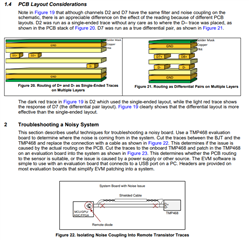Other Parts Discussed in Thread: , DXP, ISOTMP35
Tool/software:
Hello,
We are writing to you regarding a problem that we experience when reading temperature data from TI TMP-421 sensors.
Description of our application:
We use TMP421 sensors in a DC drive inverter to monitor the temperatures of 18 locations on the PCB which are near power switching MOSFET transistors that can get very hot.
Board Specification:
- Dimensions: 160 x 180mm
- Layers: 5
|
Layer |
Purpose |
Copper |
|
1 |
Signal |
40 um (1oz) |
|
2 |
Signal |
40 um (1oz) |
|
3 |
Hi current |
solid |
|
4 |
Gnd and power |
40 um (1oz) |
|
5 |
Gnd |
40 um (1oz) |
The maximum currents are up to 400 Amperes. Voltages 40-60 Volts
On each board we install 9 TMP-421 sensors in total, to each of them we connect a second sensor(transistor) to use the option of measuring a second temperature.
The distances between the main TMP421 chip and the external sensor are 3 to 27 mm.
We use full addressing - the three states of the three Tmp421 addressing pins (3 x 3 = 9 sensors).
When configuring the “floating” state, 47K / 47K resistor dividers are used to avoid floating inputs in EMI conditions.
We initiate one request to one of the sensors via I2C (100KHz) ever tens of miliseconds. In total, in about 1.5 seconds we read the data from all sensors from their registers (according to the Register Map from TI documentation):
- 0x00, Local Temperature (High Byte)
- 0x01, Remote Temperature (High Byte)
- 0x10, Local Temperature (Low Byte)
- 0x11, Remote Temperature (Low Byte)
The PVLD and Open bits are always in the correct state.
Description of the problem:
We have problems with reading incorrect data from the TMP421 sensors, and we are absolutely certain that these problems are due to electromagnetic interference.
Depending on the power at which we use the motor inverter (and which affects the electromagnetic noise), up to a certain power level, all data from all sensors is correct.
In a certain power level, some sensors stop communicating for some time, after which communication is restored again. Sometimes some sensors stop, sometimes others. There are sensors that work all the time. This fact indicates that the I2C bus is in good condition and the problem is not in the data transfer between the sensors and the processor.
At very high powers and therefore EMC, many of the sensors stop working for a long time, but there are always one or two sensors that correctly transmit their correct data.
There is one sensor (always at the same address) on the different boards tested, which always, at all powers, works correctly. This is the sensor with (Table 3. TMP421-Q1 Slave Address Options)
slave address 0%0011 100:
A1 – Float
A0 - 0
Our request to TI for assistance:
Please provide us with information regarding good practices layout of the TMP-421 under EMI conditions and share your experience and provide us with some advice and recommendations to help is solving our EMC problem with TI TMP-421.



